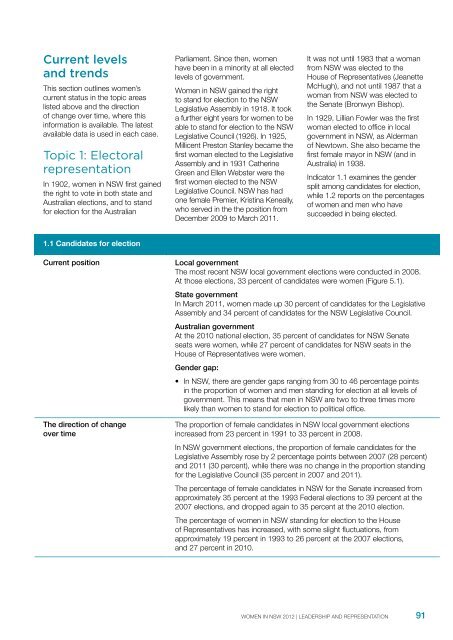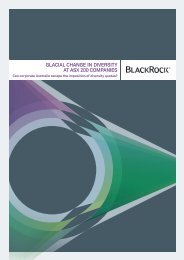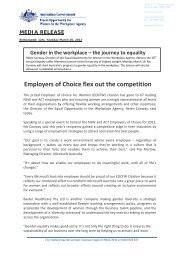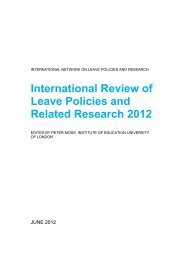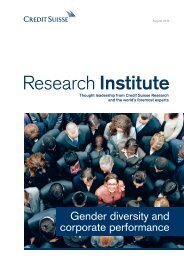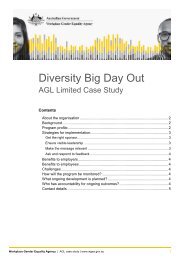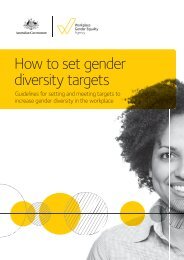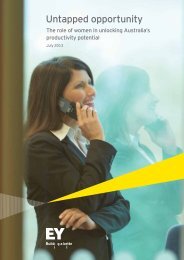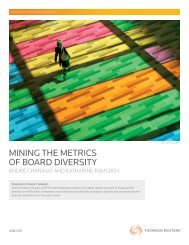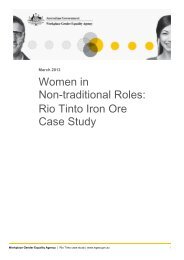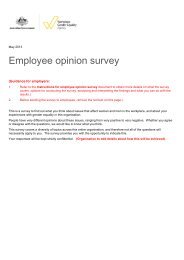Women in NSW 2012 - The Workplace Gender Equality Agency
Women in NSW 2012 - The Workplace Gender Equality Agency
Women in NSW 2012 - The Workplace Gender Equality Agency
You also want an ePaper? Increase the reach of your titles
YUMPU automatically turns print PDFs into web optimized ePapers that Google loves.
Current levelsand trendsThis section outl<strong>in</strong>es women’scurrent status <strong>in</strong> the topic areaslisted above and the directionof change over time, where this<strong>in</strong>formation is available. <strong>The</strong> latestavailable data is used <strong>in</strong> each case.Topic 1: ElectoralrepresentationIn 1902, women <strong>in</strong> <strong>NSW</strong> first ga<strong>in</strong>edthe right to vote <strong>in</strong> both state andAustralian elections, and to standfor election for the AustralianParliament. S<strong>in</strong>ce then, womenhave been <strong>in</strong> a m<strong>in</strong>ority at all electedlevels of government.<strong>Women</strong> <strong>in</strong> <strong>NSW</strong> ga<strong>in</strong>ed the rightto stand for election to the <strong>NSW</strong>Legislative Assembly <strong>in</strong> 1918. It tooka further eight years for women to beable to stand for election to the <strong>NSW</strong>Legislative Council (1926). In 1925,Millicent Preston Stanley became thefirst woman elected to the LegislativeAssembly and <strong>in</strong> 1931 Cather<strong>in</strong>eGreen and Ellen Webster were thefirst women elected to the <strong>NSW</strong>Legislative Council. <strong>NSW</strong> has hadone female Premier, Krist<strong>in</strong>a Keneally,who served <strong>in</strong> the the position fromDecember 2009 to March 2011.It was not until 1983 that a womanfrom <strong>NSW</strong> was elected to theHouse of Representatives (JeanetteMcHugh), and not until 1987 that awoman from <strong>NSW</strong> was elected tothe Senate (Bronwyn Bishop).In 1929, Lillian Fowler was the firstwoman elected to office <strong>in</strong> localgovernment <strong>in</strong> <strong>NSW</strong>, as Aldermanof Newtown. She also became thefirst female mayor <strong>in</strong> <strong>NSW</strong> (and <strong>in</strong>Australia) <strong>in</strong> 1938.Indicator 1.1 exam<strong>in</strong>es the gendersplit among candidates for election,while 1.2 reports on the percentagesof women and men who havesucceeded <strong>in</strong> be<strong>in</strong>g elected.1.1 Candidates for electionCurrent position<strong>The</strong> direction of changeover timeLocal government<strong>The</strong> most recent <strong>NSW</strong> local government elections were conducted <strong>in</strong> 2008.At those elections, 33 percent of candidates were women (Figure 5.1).State governmentIn March 2011, women made up 30 percent of candidates for the LegislativeAssembly and 34 percent of candidates for the <strong>NSW</strong> Legislative Council.Australian governmentAt the 2010 national election, 35 percent of candidates for <strong>NSW</strong> Senateseats were women, while 27 percent of candidates for <strong>NSW</strong> seats <strong>in</strong> theHouse of Representatives were women.<strong>Gender</strong> gap:• In <strong>NSW</strong>, there are gender gaps rang<strong>in</strong>g from 30 to 46 percentage po<strong>in</strong>ts<strong>in</strong> the proportion of women and men stand<strong>in</strong>g for election at all levels ofgovernment. This means that men <strong>in</strong> <strong>NSW</strong> are two to three times morelikely than women to stand for election to political office.<strong>The</strong> proportion of female candidates <strong>in</strong> <strong>NSW</strong> local government elections<strong>in</strong>creased from 23 percent <strong>in</strong> 1991 to 33 percent <strong>in</strong> 2008.In <strong>NSW</strong> government elections, the proportion of female candidates for theLegislative Assembly rose by 2 percentage po<strong>in</strong>ts between 2007 (28 percent)and 2011 (30 percent), while there was no change <strong>in</strong> the proportion stand<strong>in</strong>gfor the Legislative Council (35 percent <strong>in</strong> 2007 and 2011).<strong>The</strong> percentage of female candidates <strong>in</strong> <strong>NSW</strong> for the Senate <strong>in</strong>creased fromapproximately 35 percent at the 1993 Federal elections to 39 percent at the2007 elections, and dropped aga<strong>in</strong> to 35 percent at the 2010 election.<strong>The</strong> percentage of women <strong>in</strong> <strong>NSW</strong> stand<strong>in</strong>g for election to the Houseof Representatives has <strong>in</strong>creased, with some slight fluctuations, fromapproximately 19 percent <strong>in</strong> 1993 to 26 percent at the 2007 elections,and 27 percent <strong>in</strong> 2010.WOMEN IN <strong>NSW</strong> <strong>2012</strong> | LEADERSHIP AND REPRESENTATION91


